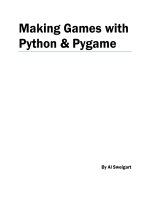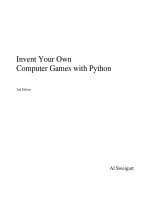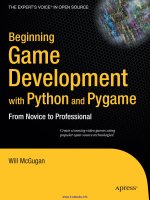Invent own game with python
Bạn đang xem bản rút gọn của tài liệu. Xem và tải ngay bản đầy đủ của tài liệu tại đây (4.84 MB, 473 trang )
i
Invent Your Own
Computer Games
with Python, 2
nd
Edition
By Al Sweigart
ii
Copyright © 2008-2012 by Albert Sweigart
Some Rights Reserved. "Invent Your Own Computer Games with Python" ("Invent with Python")
is licensed under a Creative Commons Attribution-Noncommercial-Share Alike 3.0 United States
License.
You are free:
To Share — to copy, distribute, display, and perform the work
To Remix — to make derivative works
Under the following conditions:
Attribution — You must attribute the work in the manner specified by the author or
licensor (but not in any way that suggests that they endorse you or your use of the work).
(Visibly include the title and author's name in any excerpts of this work.)
Noncommercial — You may not use this work for commercial purposes.
Share Alike — If you alter, transform, or build upon this work, you may distribute
the resulting work only under the same or similar license to this one.
This summary is located here:
Your fair use and other rights are in no way affected by the above. There is a human-readable
summary of the Legal Code (the full license), located here:
Book Version 31
If you've downloaded this book from a torrent, it’s probably out of date. Go
to to download the latest version instead.
ISBN 978-0-9821060-1-3
2.1 Edition
iii
iv
For Caro, with more love
than I ever knew I had.
v
A Note to Parents and
Fellow Programmers
Thank your for reading this book. My motivation for writing this book comes from a gap I saw in
today's literature for kids interested in learning to program. I started programming when I was 9
years old in the BASIC language with a book similar to this one. During the course of writing
this, I've realized how a modern language like Python has made programming far easier and
versatile for a new generation of programmers. Python has a gentle learning curve while still
being a serious language that is used by programmers professionally.
The current crop of programming books for kids that I've seen fell into two categories. First,
books that did not teach programming so much as "game creation software" or a dumbed-down
languages to make programming "easy" (to the point that it is no longer programming). Or
second, they taught programming like a mathematics textbook: all principles and concepts with
little application given to the reader. This book takes a different approach: show the source code
for games right up front and explain programming principles from the examples.
I have also made this book available under the Creative Commons license, which allows you to
make copies and distribute this book (or excerpts) with my full permission, as long as attribution
to me is left intact and it is used for noncommercial purposes. (See the copyright page.) I want to
make this book a gift to a world that has given me so much.
Thank you again for reading this book, and feel free to email me any questions or comments.
Al Sweigart
The full text of this book is available in HTML or PDF format at:
vi
Who is this book for?
Programming isn't hard. But it is hard to find learning materials that teach you to do interesting
things with programming. Other computer books go over many topics that most newbie coders
don't need. This book will teach you how to program your own computer games. You will learn a
useful skill and have fun games to show for it! This book is for:
Complete beginners who wants to teach themselves computer programming, even if they
have no previous experience programming.
Kids and teenagers who want to learn computer programming by creating games. Kids as
young as 9 or 10 years old should be able to follow along.
Adults and teachers who wish to teach others programming.
Anyone, young or old, who wants to learn how to program by learning a professional
programming language.
vii
TABLE OF CONTENTS
Installing Python 1
Downloading and Installing Python 2
Windows Instructions 3
Mac OS X Instructions 4
Ubuntu and Linux Instructions 4
Starting Python 4
How to Use This Book 5
The Featured Programs 5
Line Numbers and Spaces 6
Text Wrapping in This Book 6
Tracing the Program Online 7
Checking Your Code Online 7
Summary 7
The Interactive Shell 8
Some Simple Math Stuff 8
Integers and Floating Point Numbers 9
Expressions 10
Evaluating Expressions 11
Expressions Inside Other Expressions 12
Storing Values in Variables 12
Using More Than One Variable 15
Overwriting Variables 16
Summary 17
Strings 18
Strings 18
String Concatenation 19
viii
Writing Programs in IDLE's File Editor 20
Hello World! 20
hello.py 21
Saving Your Program 22
Opening The Programs You've Saved 23
How the “Hello World” Program Works 24
Comments 24
Functions 25
The print() function 25
The input() function 25
Ending the Program 26
Variable Names 27
Summary 27
Guess the Number 29
The “Guess the Number” Game 29
Sample Run of “Guess the Number” 30
Guess the Number's Source Code 30
The import statement 32
The random.randint() function 33
Calling Functions that are Inside Modules 35
Passing Arguments to Functions 35
Welcoming the Player 36
Loops 37
Blocks 37
The Boolean Data Type 38
Comparison Operators 38
Conditions 39
Experiment with Booleans, Comparison Operators, and Conditions 39
Looping with while statements 41
ix
The Player Guesses 43
Converting Strings to Integers with the int() function 43
Incrementing Variables 45
if statements 45
Is the Player's Guess Too Low? 45
Is the Player's Guess Too High? 47
Leaving Loops Early with the break statement 47
Check if the Player Won 48
Check if the Player Lost 48
Summary: What Exactly is Programming? 49
A Web Page for Program Tracing 50
Jokes 52
Making the Most of print() 52
Sample Run of Jokes 52
Joke's Source Code 53
How the Code Works 53
Escape Characters 54
Some Other Escape Characters 54
Quotes and Double Quotes 55
The end Keyword Argument 56
Summary 56
Dragon Realm 58
Introducing Functions 58
How to Play “Dragon Realm” 59
Sample Run of Dragon Realm 59
Dragon Realm's Source Code 59
How the Code Works 61
Defining the displayIntro() Function 61
def Statements 62
x
Defining the chooseCave() Function 62
Boolean Operators 63
Evaluating an Expression That Contains Boolean Operators 63
Experimenting with the and and or Operators 64
Experimenting with the not Operator 65
Truth Tables 66
Getting the Player's Input 66
Return Values 67
Variable Scope 67
Global Scope and Local Scope 68
Defining the checkCave() Function 69
Parameters 70
Where to Put Function Definitions 71
Displaying the Game Results 72
Deciding Which Cave has the Friendly Dragon 72
The Colon : 74
Where the Program Really Begins 74
Calling the Functions in Our Program 74
Asking the Player to Play Again 75
Designing the Program 76
Summary 77
Using the Debugger 78
Bugs! 78
The Debugger 80
Starting the Debugger 80
Stepping 82
Click the Step button twice to run the two import lines. 82
Click the Step button three more times to execute the three def statements. 82
Click the Step button again to define the playAgain variable. 82
xi
The Go and Quit Buttons 83
Stepping Into, Over, and Out 83
Find the Bug 85
Break Points 88
Example of Using Break Points 89
Summary 91
Flow Charts 92
How to Play “Hangman” 92
Sample Run of “Hangman” 92
ASCII Art 94
Designing a Program with a Flowchart 95
Creating the Flow Chart 97
Branching from a Flowchart Box 98
Ending or Restarting the Game 100
Guessing Again 101
Offering Feedback to the Player 103
Summary: The Importance of Planning Out the Game 104
Hangman 106
Hangman's Source Code 107
How the Code Works 110
Multi-line Strings 111
Constant Variables 112
Lists 112
Changing the Values of List Items with Index Assignment 114
List Concatenation 115
The in Operator 115
Removing Items from Lists with del Statements 116
Lists of Lists 117
Methods 118
xii
The lower() and upper() String Methods 118
The reverse() and append() List Methods 119
The Difference Between Methods and Functions 120
The split() List Method 120
How the Code Works 121
Displaying the Board to the Player 122
The range() and list() Functions 124
for Loops 124
A while Loop Equivalent of a for Loop 127
Slices and Slicing 128
Displaying the Secret Word with Blanks 129
Replacing the Underscores with Correctly Guessed Letters 129
Get the Player's Guess 131
elif (“Else If”) Statements 132
Making Sure the Player Entered a Valid Guess 134
Asking the Player to Play Again 135
Review of the Functions We Defined 136
The Main Code for Hangman 138
Setting Up the Variables 138
Displaying the Board to the Player 138
Letting the Player Enter Their Guess 138
Checking if the Letter is in the Secret Word 139
Checking if the Player has Won 139
When the Player Guesses Incorrectly 141
Making New Changes to the Hangman Program 143
Dictionaries 145
Getting the Size of Dictionaries with len() 145
The Difference Between Dictionaries and Lists 146
Sets of Words for Hangman 148
xiii
The random.choice() Function 148
Evaluating a Dictionary of Lists 149
Multiple Assignment 151
Printing the Word Category for the Player 152
Summary 152
Tic Tac Toe 153
Sample Run of Tic Tac Toe 154
Source Code of Tic Tac Toe 155
Designing the Program 160
Representing the Board as Data 161
Game AI 162
How the Code Works: Lines 1 to 81 163
The Start of the Program 163
Printing the Board on the Screen 164
Letting the Player be X or O 167
Deciding Who Goes First 168
Asking the Player to Play Again 169
Placing a mark on the Board 169
List References 169
Using List References in makeMove() 173
Checking if the Player Has Won 174
Duplicating the Board Data 177
Checking if a Space on the Board is Free 177
Letting the Player Enter Their Move 177
Short-Circuit Evaluation 178
An Example of Short-Circuit Evaluation 179
The First if statement (Cats and Dogs) 181
The Second if statement (Hello and Goodbye) 181
The Third if statement (Spam and Cheese) 181
xiv
The Fourth if statement (Red and Blue) 181
How the Code Works: Lines 83 to 94 182
Choosing a Move from a List of Moves 182
The None Value 183
How the Code Works: Lines 96 to 187 183
Creating the Computer's Artificial Intelligence 183
The Computer Checks if it Can Win in One Move 184
The Computer Checks if the Player Can Win in One Move 184
Checking the Corner, Center, and Side Spaces (in that Order) 185
Checking if the Board is Full 185
The Start of the Game 186
Deciding the Player's Mark and Who Goes First 186
Running the Player's Turn 187
Running the Computer's Turn 188
Summary: Creating Game-Playing Artificial Intelligences 190
Bagels 191
Sample Run 192
Bagel's Source Code 192
Designing the Program 194
How the Code Works: Lines 1 to 9 196
Shuffling a Unique Set of Digits 196
The random.shuffle() Function 196
Getting the Secret Number from the Shuffled Digits 197
Augmented Assignment Operators 198
How the Code Works: Lines 11 to 24 198
The sort() List Method 200
The join() String Method 200
How the Code Works: Lines 29 to 53 201
Checking if a String Only has Numbers 201
xv
Finding out if the Player Wants to Play Again 202
The Start of the Game 202
String Interpolation 203
How the Code Works: Lines 55 to 76 204
Creating the Secret Number 204
Getting the Player's Guess 205
Getting the Clues for the Player's Guess 205
Checking if the Player Won or Lost 205
Asking the Player to Play Again 206
Summary: Getting Good at Bagels 206
Cartesian Coordinates 208
Grids and Cartesian Coordinates 209
Negative Numbers 210
Math Tricks 213
Trick 1: “A Minus Eats the Plus Sign on its Left” 213
Trick 2: “Two Minuses Combine Into a Plus” 213
Trick 3: The Commutative Property of Addition 214
Absolute Values and the abs() Function 215
Coordinate System of a Computer Monitor 216
Summary: Using this Math in Games 217
Sonar 218
Sample Run 219
Sonar's Source Code 222
Designing the Program 228
How the Code Works: Lines 1 to 38 229
Drawing the Game Board 229
Drawing the X-coordinates Along the Top 230
Drawing the Rows of the Ocean 231
Drawing the X-coordinates Along the Bottom 232
xvi
Getting the State of a Row in the Ocean 232
How the Code Works: Lines 40 to 62 233
Creating a New Game Board 233
Creating the Random Treasure Chests 235
Determining if a Move is Valid 235
How the Code Works: Lines 64 to 91 236
Placing a Move on the Board 236
An Algorithm for Finding the Closest Treasure Chest 237
The remove() List Method 240
How the Code Works: Lines 94 to 162 241
Getting the Player's Move 241
Asking the Player to Play Again 243
Printing the Game Instructions for the Player 243
How the Code Works: Lines 165 to 217 245
The Start of the Game 245
Displaying the Game Status for the Player 245
Getting the Player's Move 246
Finding a Sunken Treasure Chest 247
Checking if the Player has Won 247
Checking if the Player has Lost 248
Asking the Player to Play Again, and the sys.exit() Function 249
Summary: Review of our Sonar Game 249
Caesar Cipher 250
About Cryptography 250
The Caesar Cipher 251
ASCII, and Using Numbers for Letters 253
The chr() and ord() Functions 254
Sample Run of Caesar Cipher 255
Caesar Cipher's Source Code 256
xvii
How the Code Works: Lines 1 to 34 257
Deciding to Encrypt or Decrypt 258
Getting the Message from the Player 258
Getting the Key from the Player 258
Encrypt or Decrypt the Message with the Given Key 259
The isalpha() String Method 259
The isupper() and islower() String Methods 260
How the Code Works: Lines 36 to 57 261
Encrypting or Decrypting Each Letter 261
The Start of the Program 262
Brute Force 263
Adding the Brute Force Mode to Our Program 263
Summary: Reviewing Our Caesar Cipher Program 265
Reversi 267
Sample Run 270
Reversi's Source Code 273
How the Code Works 281
The Game Board Data Structure 281
Importing Other Modules 281
Drawing the Board Data Structure on the Screen 282
Resetting the Game Board 284
Setting Up the Starting Pieces 284
Creating a New Game Board Data Structure 285
Checking if a Move is Valid 285
Checking Each of the Eight Directions 287
Finding Out if There are Pieces to Flip Over 288
Checking for Valid Coordinates 289
Getting a List with All Valid Moves 290
The bool() Function 291
xviii
Getting the Score of the Game Board 292
Getting the Player's Tile Choice 292
Determining Who Goes First 293
Asking the Player to Play Again 293
Placing Down a Tile on the Game Board 293
Copying the Board Data Structure 294
Determining if a Space is on a Corner 295
Getting the Player's Move 295
Getting the Computer's Move 297
Corner Moves are the Best Moves 297
Get a List of the Best Scoring Moves 298
Simulate All Possible Moves on Duplicate Board Data Structures 298
Printing the Scores to the Screen 299
The Start of the Game 300
Running the Player's Turn 300
Handling the Quit or Hints Commands 301
Make the Player's Move 302
Running the Computer's Turn 302
Drawing Everything on the Screen 303
Ask the Player to Play Again 304
Changing the drawBoard() Function 304
Summary: Reviewing the Reversi Game 305
AI Simulation 307
Making the Computer Play Against Itself 308
How the AISim1.py Code Works 309
Making the Computer Play Itself Several Times 310
How the AISim2.py Code Works 312
Percentages 313
Division Evaluates to Floating Point 313
xix
The round() function 314
Displaying the Statistics 315
Comparing Different AI Algorithms 316
How the AISim3.py Code Works 318
Comparing the Random Algorithm Against the Regular Algorithm 318
Comparing the Random Algorithm Against Itself 319
Comparing the Regular Algorithm Against the CornersSideBest Algorithm 320
Comparing the Regular Algorithm Against the Worst Algorithm 321
Comparing the Regular Algorithm Against the WorstCorner Algorithm 321
Comparing the Worst Algorithm Against the WorstCorner Algorithm 322
Summary: Learning New Things by Running Simulation Experiments 322
Graphics and Animation 324
Installing Pygame 325
Hello World in Pygame 326
Hello World's Source Code 327
Running the Hello World Program 328
Importing the Pygame Module 329
The pygame.init() Function 330
The pygame.display.set_mode() and pygame.display.set_caption()
Functions 330
Colors in Pygame 331
Fonts, and the pygame.font.SysFont() Function 333
The render() Method for Font Objects 333
Attributes 334
The get_rect() Methods for pygame.font.Font and pygame.Surface Objects
336
Constructor Functions and the type() Function 336
The fill() Method for Surface Objects 337
The pygame.draw.polygon() Function 337
xx
The pygame.draw.line() Function 338
The pygame.draw.circle() Function 338
The pygame.draw.ellipse() Function 339
The pygame.draw.rect() Function 339
The pygame.PixelArray Data Type 339
The blit() Method for Surface Objects 340
The pygame.display.update() Function 340
Events and the Game Loop 341
The pygame.event.get() Function 341
The pygame.quit() Function 342
Animation 342
The Animation Program's Source Code 342
How the Animation Program Works 345
Moving and Bouncing the Blocks 345
Creating and Setting Up Pygame and the Main Window 346
Setting Up Constant Variables for Direction 347
Setting Up Constant Variables for Color 348
Setting Up The Block Data Structures 348
Running the Game Loop 349
Moving Each Block 350
Checking if the Block has Bounced 350
Changing the Direction of the Bouncing Block 351
Drawing the Blocks on the Window in Their New Positions 352
Drawing the Window on the Screen 352
Some Small Modifications 353
Drawing as Fast as Possible 353
Drawing Trails of Blocks 353
Summary: Pygame Programming 354
Collision Detection and Input 355
xxi
The Collision Detection Program's Source Code 356
Importing the Modules 360
The Collision Detection Function 360
Determining if a Point is Inside a Rectangle 362
The pygame.time.Clock Object and tick() Method 363
Setting Up the Window and Data Structures 364
Drawing the Bouncer on the Screen 365
Colliding with the Food Squares 366
Don't Add to or Delete from a List while Iterating Over It 366
Removing the Food Squares 367
Drawing the Food Squares on the Screen 367
The Keyboard Input Program's Source Code 367
Setting Up the Window and Data Structures 370
Events and Handling the KEYDOWN Event 371
Setting the Four Keyboard Variables 373
Handling the KEYUP Event 374
Teleporting the Player 375
Handling the MOUSEBUTTONUP Event 375
Moving the Bouncer Around the Screen 375
The colliderect() Method 376
Summary: Collision Detection and Pygame Input 376
Sound and Images 378
Image and Sound Files 380
Sprites and Sounds Program 380
The Sprites and Sounds Program's Source Code 380
Setting Up the Window and the Data Structure 384
The pygame.transform.scale() Function 385
Setting Up the Music and Sounds 385
Toggling the Sound On and Off 386
xxii
Drawing the Player on the Window 387
Checking if the Player Has Collided with Cherries 387
Draw the Cherries on the Window 388
Summary: Games with Graphics and Sounds 388
Dodger 389
Review of the Basic Pygame Data Types 389
Dodger's Source Code 391
Importing the Modules 396
Setting Up the Constant Variables 397
Defining Functions 398
Initializing Pygame and Setting Up the Window 400
Fullscreen Mode 401
Display the Start Screen 402
Start of the Main Game Code 403
The Game Loop 405
Event Handling 405
The move_ip() Method for Rect objects 409
Adding New Baddies 410
Moving the Player's Character 411
The pygame.mouse.set_pos() Function 412
Implementing the Cheat Codes 413
Removing the Baddies 413
Drawing the Window 414
Drawing the Player's Score 415
Drawing the Player's Character 415
Collision Detection 416
The Game Over Screen 416
Modifying the Dodger Game 417
Summary: Creating Your Own Games 418
xxiii
The print() Function and the print statement 420
The input() and raw_input() Functions 421
The range() Function's Return Value 421
Division with the / Operator 421
Formatting Strings with the format() Method and %s 422
Statements 424
Assignment Statements 424
break Statements 425
continue Statements 425
def Statements 426
del Statements 427
for Loop Statements 427
import Statements 428
if, elif, else Statements 428
return Statements 429
while Loop Statements 429
Functions 429
The abs() Function 429
The bool() Function 430
The chr() Function 430
The float() Function 430
The input() Function 430
The int() Function 431
The list() Function 431
The ord() Function 431
The print() Function 431
The range() Function 432
The round() Function 433
xxiv
The str() Function 433
The type() Function 433
Functions in the random Module 434
The random.choice() Function 434
The random.randint() Function 434
The random.shuffle() Function 434
Functions in the sys Module 435
The sys.exit() Function 435
Functions in the time Module 435
The time.sleep() Function 435
Methods 435
Dict Methods 435
The keys() Dict Method 435
The values() Dict Method 436
List Methods 436
The append() List Method 436
The reverse() List Method 436
The sort() List Method 436
String Methods 437
The endswith() String Method 437
The isalpha() String Method 437
The isdigit() String Method 437
The islower() string Method 438
The isupper() String Method 438
The join() String Method 438
The lower() String Method 438
The split() String Method 439
The startswith() String Method 439
xxv
The upper() String Method 439
Step 1: Download and Install py2exe 441
Step 2: Create Your setup.py Script 442
Step 3: Run Your setup.py Script 442
Step 4: Distribute Your Program 443
Summary 443
SyntaxError: invalid syntax 444
ImportError: No module named raandom 445
SyntaxError: EOL while scanning string literal 445
AttributeError: 'str' object has no attribute 'lowerr' 445
IndentationError: expected an indented block 445
IndentationError: unexpected indent 446
IndentationError: unindent does not match any outer indentation level 446
TypeError: bad operand type for abs(): 'str' 446
TypeError: abs() takes exactly one argument (2 given) 446
IndexError: list index out of range 446
KeyError: 'spam' 447









